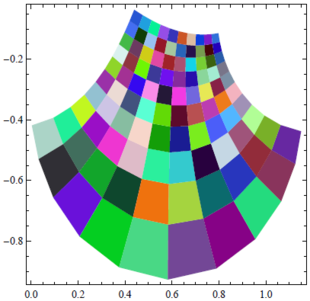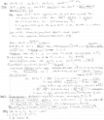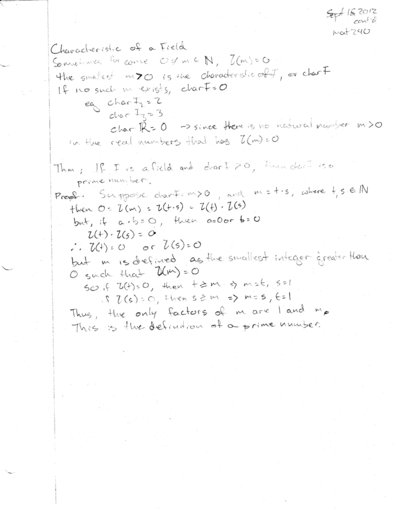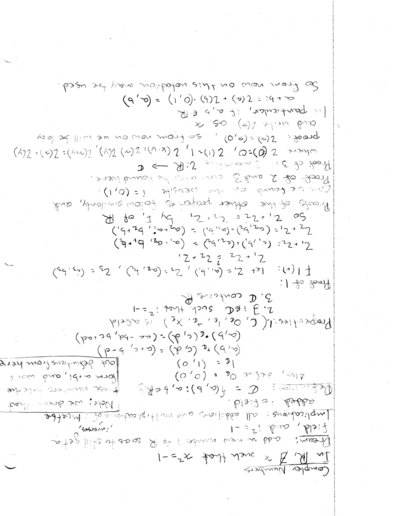12-240/Classnotes for Tuesday September 18: Difference between revisions
| (7 intermediate revisions by 5 users not shown) | |||
| Line 1: | Line 1: | ||
{{12-240/Navigation}} |
{{12-240/Navigation}} |
||
Today's handout, "TheComplexField", can be had from {{Pensieve link|Classes/12-240|Pensieve: Classes: 12-240}}. |
|||
{{Template:12-240:Dror/Students Divider}} |
|||
In this class, the professor continued with some more theorems of field and introduced definition and theorems of complex number. |
In this class, the professor continued with some more theorems of field and introduced definition and theorems of complex number. |
||
| Line 73: | Line 78: | ||
∃ m≠0, m ∈ '''N''', Ɩ(m) =0 |
∃ m≠0, m ∈ '''N''', Ɩ(m) =0 |
||
In which case, there is a smallest m |
In which case, there is a smallest m>0, for which Ɩ(m)=0. '''m' is the characteristic of F.'' Denoted char(F). |
||
Examples: char(F_2)=2, char(F_3)=3... but NOTE: char('''R''')=0 |
Examples: char(F_2)=2, char(F_3)=3... but NOTE: char('''R''')=0 |
||
| Line 107: | Line 112: | ||
Define addition: (a,b)+(c,d) = (a+c, b+d) |
Define addition: (a,b)+(c,d) = (a+c, b+d) |
||
Define multification: (a,b)(c,d) = ( |
Define multification: (a,b)(c,d) = (ac-bd, ad+bc) |
||
| Line 141: | Line 146: | ||
Thus i^2=-1. ∎ |
Thus i^2=-1. ∎ |
||
Proof 3: |
Proof 3: |
||
Given the field '''C''' : map J: '''R''' -> '''C''' |
Given the field '''C''' : map J: '''R''' -> '''C''' |
||
1) J(0)=(0,0); J(1)=(1,0) |
1) J(0)=(0,0); J(1)=(1,0) |
||
| Line 156: | Line 163: | ||
So, what does a+b𝒊 mean? (a, b ∈ '''R''') |
So, what does a+b𝒊 mean? (a, b ∈ '''R''') |
||
a+b𝒊= Ɩ(a) + Ɩ(b) |
a+b𝒊= Ɩ(a) + Ɩ(b)∙Ɩ(𝒊) = (a,0) + (b,0)∙(0,1) = (a,b) |
||
Hence, (a,b) ~ a+b𝒊 |
Hence, (a,b) ~ a+b𝒊 |
||
| Line 162: | Line 169: | ||
Thus, we can use a+b𝒊 with less hesitation. |
Thus, we can use a+b𝒊 with less hesitation. |
||
== Lecture 3, scanned notes upload by [[User:Starash|Starash]] == |
== Lecture 3, scanned notes upload by [[User:Starash|Starash]] and [[User:KJMorenz|KJMorenz]]== |
||
<gallery> |
<gallery> |
||
| Line 169: | Line 176: | ||
Image:12-240-0918-3.jpg|Page 3 |
Image:12-240-0918-3.jpg|Page 3 |
||
</gallery> |
</gallery> |
||
[[Image:12-240-CharacteristicOfField.jpg|400px]] |
|||
[[Image:12-240-ComplexNums.jpg|400px]] |
|||
Latest revision as of 04:37, 7 December 2012
| |||||||||||||||||||||||||||||||||||||||||||||||||||||||||
Today's handout, "TheComplexField", can be had from Pensieve: Classes: 12-240.
| Dror's notes above / Students' notes below |
In this class, the professor continued with some more theorems of field and introduced definition and theorems of complex number.
Various properties of fields
Thrm 1: In a field F: 1. a+b = c+b ⇒ a=c
2. b≠0, a∙b=c∙b ⇒ a=c
3. 0 is unique.
4. 1 is unique.
5. -a is unique.
6. a^-1 is unique (a≠0)
7. -(-a)=a
8. (a^-1)^-1 =a
9. a∙0=0 **Surprisingly difficult, required distributivity.
10. ∄ 0^-1, aka, ∄ b∈F s.t 0∙b=1
11. (-a)∙(-b)=a∙b
12. a∙b=0 iff a=0 or b=0
. . .
16. (a+b)∙(a-b)= a^2 - b^2 [Define a^2 = a∙a] Hint: Use distributive law
Thrm 2: Given a field F, there exists a map Ɩ: Z → F with the properties (∀ m,n ∈ Z):
1) Ɩ(0) =0, Ɩ(1)=1
2) Ɩ(m+n) = Ɩ(m) +Ɩ(n)
3) Ɩ(mn) = Ɩ(m)∙Ɩ(n)
Furthermore, Ɩ is unique.
Rough proof:
Test somes cases:
Ɩ(2) = Ɩ(1+1) = Ɩ(1) + Ɩ(1) = 1 + 1 ≠ 2
Ɩ(3) = Ɩ(2 +1)= Ɩ(2) + Ɩ(1) = 1+ 1+ 1 ≠ 3
. . .
Ɩ(n) = 1 + ... + 1 (n times)
Ɩ(-3) = ?
Ɩ(-3 + 3) = Ɩ(-3) + Ɩ(3) ⇒ Ɩ(-3) = -Ɩ(3) = -(1+1+1)
What about uniqueness? Simply put, we had not choice in the definition of Ɩ. All followed from the given properties.
At this point, we will be lazy and simply denote Ɩ(3) = 3_f [3 with subscript f]
∃ m≠0, m ∈ N, Ɩ(m) =0
In which case, there is a smallest m>0, for which Ɩ(m)=0. 'm' is the characteristic of F. Denoted char(F). Examples: char(F_2)=2, char(F_3)=3... but NOTE: char(R)=0
Thrm: If F is a field and char(F) >0, then char(F) is a prime number.
Proof: Suppose char(F) =m, m>0. Suppose also m is not prime: m=ts, t,s ∈ N.
Then, Ɩ(m) = 0 = Ɩ(t)∙Ɩ(s) ⇒ Ɩ(t)=0 or Ɩ(s)=0 by P12.
If Ɩ(t)=0 ⇒ t≧m ⇒ m=t, s=1 or likewise for Ɩ(s)=0, and m=s, t=1
In any factorization of m, one of the factors is m and the other is 1. So m is prime. ∎
Complex number
Abstraction, generalization, definition, examples, properties, dream, implications, realization = formalization, PROOF.
Consider that fact that in R, ∄ x s.t. x^2 = -1
Dream: Add new number element 𝒊 to R, so as to still get a field & 𝒊^2 = -1
Implications: By adding 𝒊, we must add 7𝒊, and 2+7𝒊, 3+4𝒊, (2+7𝒊)∙(3+4𝒊), (2+7𝒊)^-1, etc.
So, how do we define this field?
Definition
C = {(a,b): a,b ∈ R} Also, 0 (of the field) = (0,0); 1( of the field) = (1,0)
Define addition: (a,b)+(c,d) = (a+c, b+d)
Define multification: (a,b)(c,d) = (ac-bd, ad+bc)
Theorems:
Thrm. 1. (C, 0, 1, +, ∙) is a field.
Thrm. 2. ∃ 𝒊 ∈ C s.t. 𝒊^2 = -1
Thrm. 3. C contains R
Proof (1): Show that each of the field axioms holds for C.
Ex. F1(a): ƶ1 + ƶ2 = ƶ2 + ƶ1, where ƶ1 = (a1, b1) and ƶ2 = (a2, b2)
LHS: (a1,b1)+(a2,b2) = (a1+a2, b1+b2)
RHS: (a2,b2)+(a1,b1) = (a2+a1, b2+b1)
LHS=RHS by F1 of R
F1(b) and so on...
Proof (2):
In C, consider i=(0,1)
By the definition i^2=i.i=(0.1-1.1,0.1+1.0)=(-1,0)
We also have 1(of c) + (-1,0)=(1,0)+(-1,0)=(0,0)=0 (of c)
Hence (-1,0) is the addictive inverse of 1, i.e, (-1,0)=-1
Thus i^2=-1. ∎
Proof 3:
Given the field C : map J: R -> C
1) J(0)=(0,0); J(1)=(1,0)
2) J(x+y)=J(x)+J(y); J(x.y)=J(x)J(y)
Define J(x)=(x,0), all will follow.
From now on J(x) will be writen simply x
EX: J(7)=7, J(3)=3
So, what does a+b𝒊 mean? (a, b ∈ R)
a+b𝒊= Ɩ(a) + Ɩ(b)∙Ɩ(𝒊) = (a,0) + (b,0)∙(0,1) = (a,b)
Hence, (a,b) ~ a+b𝒊
Thus, we can use a+b𝒊 with less hesitation.






